Education/Teaching of Individuals with Orthopedic and Other Physical Health Impairments
Types of Degrees Education/Teaching of Individuals with Orthopedic and Other Physical Health Impairments Majors Are Getting
The following table lists how many education/teaching of individuals with orthopedic & other physical health impairments graduations there were for each degree level during the last year for which data was available.
| Education Level | Number of Grads |
|---|---|
| Bachelor’s Degree | 34 |
| Graduate Certificate | 3 |
What Education/Teaching of Individuals with Orthopedic and Other Physical Health Impairments Majors Need to Know
People with careers related to education/teaching of individuals with orthopedic and other physical health impairments were asked what knowledge areas, skills, and abilities were important for their jobs. They weighted these areas on a scale of 1 to 5 with 5 being the highest.
Knowledge Areas for Education/Teaching of Individuals with Orthopedic and Other Physical Health Impairments Majors
This major prepares you for careers in which these knowledge areas are important:
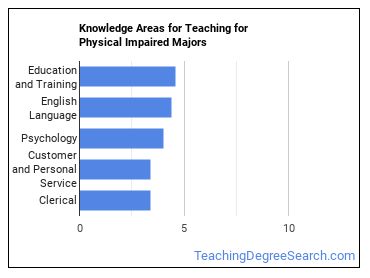
- Education and Training - Knowledge of principles and methods for curriculum and training design, teaching and instruction for individuals and groups, and the measurement of training effects.
- English Language - Knowledge of the structure and content of the English language including the meaning and spelling of words, rules of composition, and grammar.
- Psychology - Knowledge of human behavior and performance; individual differences in ability, personality, and interests; learning and motivation; psychological research methods; and the assessment and treatment of behavioral and affective disorders.
- Customer and Personal Service - Knowledge of principles and processes for providing customer and personal services. This includes customer needs assessment, meeting quality standards for services, and evaluation of customer satisfaction.
- Clerical - Knowledge of administrative and clerical procedures and systems such as word processing, managing files and records, stenography and transcription, designing forms, and other office procedures and terminology.
Skills for Education/Teaching of Individuals with Orthopedic and Other Physical Health Impairments Majors
education/teaching of individuals with orthopedic and other physical health impairments majors are found most commonly in careers in which the following skills are important:
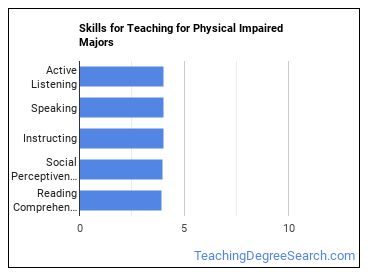
- Active Listening - Giving full attention to what other people are saying, taking time to understand the points being made, asking questions as appropriate, and not interrupting at inappropriate times.
- Speaking - Talking to others to convey information effectively.
- Instructing - Teaching others how to do something.
- Social Perceptiveness - Being aware of others' reactions and understanding why they react as they do.
- Reading Comprehension - Understanding written sentences and paragraphs in work related documents.
Abilities for Education/Teaching of Individuals with Orthopedic and Other Physical Health Impairments Majors
As you progress with your education/teaching of individuals with orthopedic and other physical health impairments degree, there are several abilities you should pick up that will help you in whatever related career you choose. These abilities include:
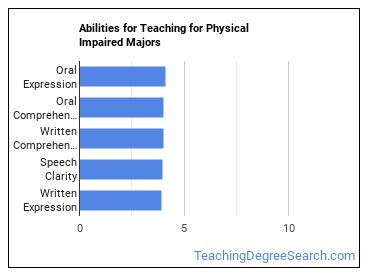
- Oral Expression - The ability to communicate information and ideas in speaking so others will understand.
- Oral Comprehension - The ability to listen to and understand information and ideas presented through spoken words and sentences.
- Written Comprehension - The ability to read and understand information and ideas presented in writing.
- Speech Clarity - The ability to speak clearly so others can understand you.
- Written Expression - The ability to communicate information and ideas in writing so others will understand.
What Can You Do With a Education/Teaching of Individuals with Orthopedic and Other Physical Health Impairments Major?
People with a education/teaching of individuals with orthopedic and other physical health impairments degree often go into the following careers:
| Job Title | Job Growth Rate | Median Salary |
|---|---|---|
| Adapted Physical Education Specialists | 9.9% | $56,680 |
| Special Education Teachers, Kindergarten and Elementary School | 7.4% | $59,390 |
| Special Education Teachers, Middle School | 7.2% | $60,250 |
| Special Education Teachers, Preschool | 11.3% | $55,840 |
| Special Education Teachers, Secondary School | 7.4% | $60,600 |
Who Is Getting a Bachelor’s Degree in Education/Teaching of Individuals with Orthopedic and Other Physical Health Impairments?
Racial-Ethnic Diversity
At the countrywide level, the racial-ethnic distribution of education/teaching of individuals with orthopedic and other physical health impairments majors is as follows:
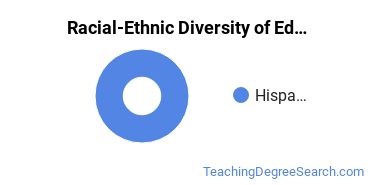
| Race/Ethnicity | Number of Grads |
|---|---|
| Asian | 0 |
| Black or African American | 0 |
| Hispanic or Latino | 33 |
| White | 1 |
| International Students | 0 |
| Other Races/Ethnicities | 0 |
Amount of Education Required for Careers Related to Education/Teaching of Individuals with Orthopedic and Other Physical Health Impairments
Some careers associated with education/teaching of individuals with orthopedic and other physical health impairments require an advanced degree while some may not even require a bachelor’s. In general, the more advanced your degree the more career options will open up to you. However, there is significant time and money that needs to be invested into your education so weigh the pros and cons.
How much schooling do you really need to compete in today’s job market? People currently working in careers related to education/teaching of individuals with orthopedic and other physical health impairments have obtained the following education levels.
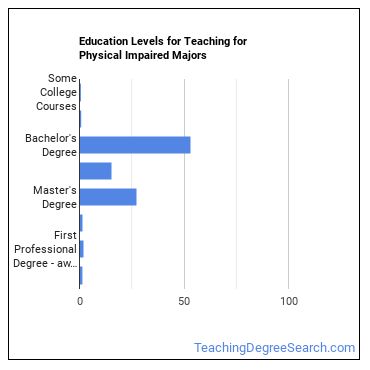
| Education Level | Percentage of Workers |
|---|---|
| Some College Courses | 0.4% |
| Associate’s Degree (or other 2-year degree) | 0.6% |
| Bachelor’s Degree | 53.0% |
| Post-Baccalaureate Certificate - awarded for completion of an organized program of study; designed for people who have completed a Baccalaureate degree but do not meet the requirements of academic degrees carrying the title of Master. | 15.5% |
| Master’s Degree | 27.2% |
| Post-Master’s Certificate - awarded for completion of an organized program of study; designed for people who have completed a Master’s degree but do not meet the requirements of academic degrees at the doctoral level. | 1.4% |
| First Professional Degree - awarded for completion of a program that: requires at least 2 years of college work before entrance into the program, includes a total of at least 6 academic years of work to complete, and provides all remaining academic requirements to begin practice in a profession. | 1.7% |
| Doctoral Degree | 1.2% |
Online Education/Teaching of Individuals with Orthopedic and Other Physical Health Impairments Programs
The following table lists the number of programs by degree level, along with how many schools offered online courses in the field.
| Degree Level | Colleges Offering Programs | Colleges Offering Online Classes |
|---|---|---|
| Certificate (Less Than 1 Year) | 0 | 0 |
| Certificate (1-2 years) | 0 | 0 |
| Certificate (2-4 Years) | 0 | 0 |
| Associate’s Degree | 0 | 0 |
| Bachelor’s Degree | 1 | 0 |
| Post-Baccalaureate | 0 | 0 |
| Master’s Degree | 3 | 0 |
| Post-Master’s | 1 | 0 |
| Doctor’s Degree (Research) | 2 | 0 |
| Doctor’s Degree (Professional Practice) | 0 | 0 |
| Doctor’s Degree (Other) | 0 | 0 |
Explore Major by State
Alabama
California
District of Columbia
Idaho
Kansas
Maryland
Mississippi
Nevada
New York
Oklahoma
South Carolina
Utah
West Virginia
Alaska
Colorado
Florida
Illinois
Kentucky
Massachusetts
Missouri
New Hampshire
North Carolina
Oregon
South Dakota
Vermont
Wisconsin
Majors Related to Education/Teaching of Individuals with Orthopedic and Other Physical Health Impairments
You may also be interested in one of the following majors related to education/teaching of individuals with orthopedic and other physical health impairments.
References
*The racial-ethnic minorities count is calculated by taking the total number of students and subtracting white students, international students, and students whose race/ethnicity was unknown. This number is then divided by the total number of students at the school to obtain the racial-ethnic minorities percentage.
- College Factual
- College Scorecard
- National Center for Education Statistics
- O*NET Online
- U.S. Bureau of Labor Statistics
- Usual Weekly Earnings of Wage and Salary Workers First Quarter 2020
- Image Credit: By woodleywonderworks under License
More about our data sources and methodologies.
